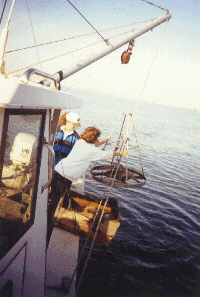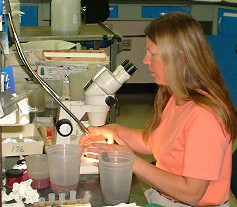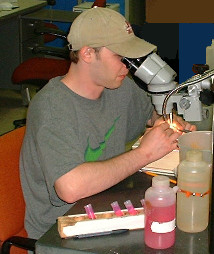|
Samples are collected using four kinds of gear depending on the program
element and habitat type. At fixed stations, a hand-operated box corer
("post-hole digger"), which samples a 250 cm2 area to a depth of 25 cm, is
used in the nearshore shallow habitats of the mainstem bay and tributaries. A
Wildco box corer, which samples an area of 225 cm2 to a depth of 23 cm, is
used in deep-water (more than 4 m) habitats in the mainstem bay and
tributaries. A Petite Ponar grab, which samples 250 cm2 to a depth of
7 cm, is used at the fixed site in the Nanticoke River to be consistent
with previous sampling in the 1980s. These different gears are used to be
consistent with historical methods and for data collected at historical sites to
be comparable. At two fixed stations first sampled in 1995 and at all
probability sites, a Young grab, which samples an area
of 440 cm2 to a depth of 10 cm, is used (the upper picture on this page illustrates
a Versar crew deploying the Young grab).
At each sampling location, sample volume and penetration depth are measured for all
samples. If the Wildco and hand-operated box cores penetrate less than
15 cm, or the Young and Petite Ponar grabs penetrate less than 7 cm into the
sediment, the sample is rejected and the site is re-sampled.
Three samples are collected for benthic community analysis at each fixed
station. One sample is collected at each probability site. Samples are
sieved in situ through a 0.5-mm screen using an elutriative process. Organisms
and detritus retained on the screen are transferred into labeled jars and preserved
in a 10% formaldehyde solution stained with Rose Bengal (a vital stain that aids in
separating organisms from sediments and detritus).
Two surface-sediment sub-samples of approximately 120 ml each are collected for
silt-clay, organic carbon, and nitrogen analysis from an additional grab sample at
each sampling location. They are frozen until processed in the laboratory. In
addition, the basic water quality parameters of dissolved oxygen, salinity,
conductivity, temperature, and turbidity are measured at each location
near the surface of the water column and at approximately 1 meter from the bottom
using a Hydrolab multiprobe CTD. At fixed stations, water column profiles
are conducted at 1-3 m intervals, depending on the depth of the station.
|
|



|
|
Benthic samples are processed to identify and enumerate each species present, and
to measure species-specific ash-free dry weight biomass. Organisms are sorted
from detritus under dissecting microscopes, identified to the lowest practical
taxonomic level, and counted. Oligochaetes and chironomids are mounted on
slides and examined under a compound microscope for genus and species identification.
Samples sorted by each technician are resorted on a regular basis to ensure that
all organisms are removed from extraneous material. A sorting efficiency of
95% is typically considered acceptable. Approximately 10% of all samples
processed are resorted for quality assurance. The level of effort expended
on resorts depends on the specific needs of each project but typically ranges from
5% to 20%, depending on whether the intent of the resorts is to confirm efficiency
levels and support training efforts, or to guarantee a specified efficiency level
within defined statistical confidence limits.
Species identifications are verified when organisms are transferred for biomass
measurements. A reference collection containing representative specimens of
each taxon identified is maintained in the laboratory. Questionable or unusual
species identifications are confirmed by recognized experts in the appropriate
taxonomic specialties. Contacts for taxonomic consultation include the
Smithsonian Institution, the National Museum of Canada, and the Institute of
Ocean Sciences. An extensive and current library of taxonomic and biological
literature is available in-house for reference by technical specialists processing
samples.
Ash-free dry weight biomass is measured directly for each species by drying the
organisms to a constant weight at 60°C and ashing in a muffle furnace at 500°C for
four hours.
Sediment samples are analyzed for percent silt-clay content, and carbon and
nitrogen content. Sand is separated from mud by wet-sieving through a 63-µm
sieve, and the silt-clay fraction of the sediment is weighed. The carbon and
nitrogen contents of dried sediments are measured with a Model CE440 Carbon Analyzer
(Exeter Analytical, Inc.) by nondispersive infrared detection. This analysis is
conducted at the Chesapeake Biological Laboratory.
|